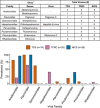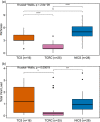Viruses in sanctuary chimpanzees across Africa
- PMID: 36329642
- PMCID: PMC9812903
- DOI: 10.1002/ajp.23452
Viruses in sanctuary chimpanzees across Africa
Abstract
Infectious disease is a major concern for both wild and captive primate populations. Primate sanctuaries in Africa provide critical protection to thousands of wild-born, orphan primates confiscated from the bushmeat and pet trades. However, uncertainty about the infectious agents these individuals potentially harbor has important implications for their individual care and long-term conservation strategies. We used metagenomic next-generation sequencing to identify viruses in blood samples from chimpanzees (Pan troglodytes) in three sanctuaries in West, Central, and East Africa. Our goal was to evaluate whether viruses of human origin or other "atypical" or unknown viruses might infect these chimpanzees. We identified viruses from eight families: Anelloviridae, Flaviviridae, Genomoviridae, Hepadnaviridae, Parvoviridae, Picobirnaviridae, Picornaviridae, and Rhabdoviridae. The majority (15/26) of viruses identified were members of the family Anelloviridae and represent the genera Alphatorquevirus (torque teno viruses) and Betatorquevirus (torque teno mini viruses), which are common in chimpanzees and apathogenic. Of the remaining 11 viruses, 9 were typical constituents of the chimpanzee virome that have been identified in previous studies and are also thought to be apathogenic. One virus, a novel tibrovirus (Rhabdoviridae: Tibrovirus) is related to Bas-Congo virus, which was originally thought to be a human pathogen but is currently thought to be apathogenic, incidental, and vector-borne. The only virus associated with disease was rhinovirus C (Picornaviridae: Enterovirus) infecting one chimpanzee subsequent to an outbreak of respiratory illness at that sanctuary. Our results suggest that the blood-borne virome of African sanctuary chimpanzees does not differ appreciably from that of their wild counterparts, and that persistent infection with exogenous viruses may be less common than often assumed.
Keywords: conservation; great ape; health; metagenomics; virome.
© 2022 The Authors. American Journal of Primatology published by Wiley Periodicals LLC.
Conflict of interest statement
The authors declare no conflict of interest.
Figures




References
-
- Adlhoch, C. , Kaiser, M. , Loewa, A. , Ulrich, M. , Forbrig, C. , Adjogoua, E. V. , Akoua‐Koffi, C. , Couacy‐Hymann, E. , Leendertz, S. A. J. , Rietschel, W. , Boesch, C. , Ellerbrok, H. , Schneider, B. S. , & Leendertz, F. H. (2012). Diversity of parvovirus 4‐like viruses in humans, chimpanzees, and monkeys in hunter‐prey relationships. Emerging Infectious Diseases, 18(5), 859–862. 10.3201/eid1805.111849 - DOI - PMC - PubMed
-
- Agresti, A. , & Coull, B. A. (1998). Approximate is better than “exact” for interval estimation of binomial proportions. The American Statistician, 52(2), 119–126. 10.1080/00031305.1998.10480550 - DOI
Publication types
MeSH terms
Grants and funding
LinkOut - more resources
Full Text Sources
Medical
Research Materials
Miscellaneous

